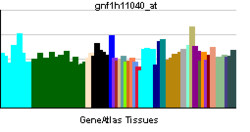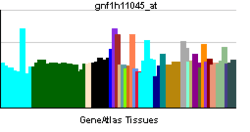OR2K2
Olfactory receptor 2K2 is a protein that in humans is encoded by the OR2K2 gene.[3][4][5]
Olfactory receptors interact with odorant molecules in the nose, to initiate a neuronal response that triggers the perception of a smell. The olfactory receptor proteins are members of a large family of G-protein-coupled receptors (GPCR) arising from single coding-exon genes. Olfactory receptors share a 7-transmembrane domain structure with many neurotransmitter and hormone receptors and are responsible for the recognition and G protein-mediated transduction of odorant signals. The olfactory receptor gene family is the largest in the genome. The nomenclature assigned to the olfactory receptor genes and proteins for this organism is independent of other organisms.[5]
See also
References
- ↑ "Human PubMed Reference:".
- ↑ "Mouse PubMed Reference:".
- ↑ Parmentier M, Libert F, Schurmans S, Schiffmann S, Lefort A, Eggerickx D, Ledent C, Mollereau C, Gerard C, Perret J, et al. (Mar 1992). "Expression of members of the putative olfactory receptor gene family in mammalian germ cells". Nature. 355 (6359): 453–5. doi:10.1038/355453a0. PMID 1370859.
- ↑ Aloni R, Olender T, Lancet D (Jan 2007). "Ancient genomic architecture for mammalian olfactory receptor clusters". Genome Biol. 7 (10): R88. doi:10.1186/gb-2006-7-10-r88. PMC 1794568
 . PMID 17010214.
. PMID 17010214. - 1 2 "Entrez Gene: OR2K2 olfactory receptor, family 2, subfamily K, member 2".
Further reading
- Strausberg RL, Feingold EA, Grouse LH, et al. (2003). "Generation and initial analysis of more than 15,000 full-length human and mouse cDNA sequences.". Proc. Natl. Acad. Sci. U.S.A. 99 (26): 16899–903. doi:10.1073/pnas.242603899. PMC 139241
 . PMID 12477932.
. PMID 12477932.
- Malnic B, Godfrey PA, Buck LB (2004). "The human olfactory receptor gene family.". Proc. Natl. Acad. Sci. U.S.A. 101 (8): 2584–9. doi:10.1073/pnas.0307882100. PMC 356993
 . PMID 14983052.
. PMID 14983052.
- Humphray SJ, Oliver K, Hunt AR, et al. (2004). "DNA sequence and analysis of human chromosome 9.". Nature. 429 (6990): 369–74. doi:10.1038/nature02465. PMC 2734081
 . PMID 15164053.
. PMID 15164053.
- Gerhard DS, Wagner L, Feingold EA, et al. (2004). "The status, quality, and expansion of the NIH full-length cDNA project: the Mammalian Gene Collection (MGC).". Genome Res. 14 (10B): 2121–7. doi:10.1101/gr.2596504. PMC 528928
 . PMID 15489334.
. PMID 15489334.
External links
This article incorporates text from the United States National Library of Medicine, which is in the public domain.
|
|---|
|
Class I
(fish-like specific receptors) | Family 51 | |
|---|
| Family 52 | |
|---|
| Family 56 | |
|---|
|
|---|
|
Class II
(tetrapod specific receptors) | Family 1 | |
|---|
| Family 2 | |
|---|
| Family 3 | |
|---|
| Family 4 | |
|---|
| Family 5 | |
|---|
| Family 6 | |
|---|
| Family 7 | |
|---|
| Family 8 | |
|---|
| Family 9 | |
|---|
| Family 10 | |
|---|
| Family 11 | |
|---|
| Family 12 | |
|---|
| Family 13 | |
|---|
|
|---|


 . PMID 17010214.
. PMID 17010214. . PMID 12477932.
. PMID 12477932. . PMID 14983052.
. PMID 14983052. . PMID 15164053.
. PMID 15164053. . PMID 15489334.
. PMID 15489334.